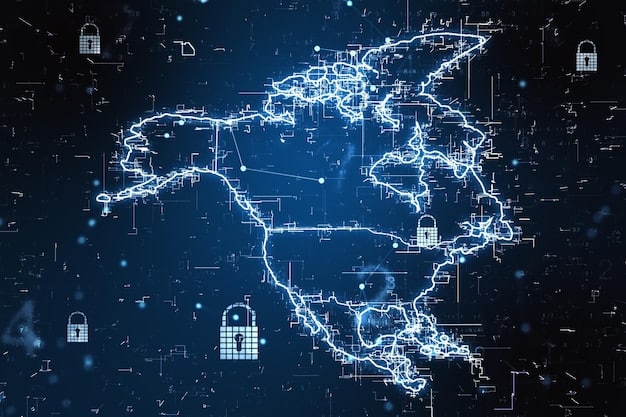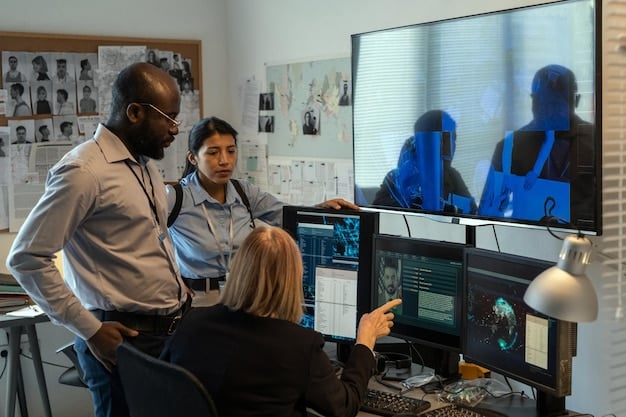Cybersecurity skills in US tech: A growing necessity

The rising tide of cyber threats underscores the critical and rapidly expanding need for robust cybersecurity skills within the United States tech industry, driving innovation and safeguarding digital infrastructure against evolving risks.
The digital age has brought unparalleled connectivity and innovation, but with it comes an inescapable shadow: the escalating threat of cyberattacks. In this environment, the growing importance of cybersecurity skills in the US tech industry is not merely a trend; it’s a fundamental shift in how businesses operate and secure their most valuable assets.
The evolving threat landscape and its impact on the US tech industry
The digital realm, while offering vast opportunities, also harbors an increasingly complex array of cyber threats. From sophisticated nation-state actors to agile cybercriminals and opportunistic hackers, the adversaries are diverse, persistent, and constantly innovating. Understanding this evolving threat landscape is paramount for the US tech industry, as it directly influences the demand for specialized cybersecurity expertise.
In recent years, the frequency and severity of cyberattacks have surged. Ransomware attacks, supply chain compromises, and data breaches have become disturbingly common, causing billions of dollars in losses and eroding public trust. The SolarWinds attack, for instance, demonstrated the profound vulnerability of even highly secure networks, highlighting the pervasive nature of modern cyber warfare.
Escalating attack vectors: Beyond traditional perimeters
Cyber threats are no longer confined to traditional network perimeters. Attackers are exploiting vulnerabilities across a broader spectrum of attack vectors, including cloud environments, IoT devices, and artificial intelligence systems. This expansion means that cybersecurity professionals must possess a wider range of knowledge to defend against these multifaceted threats effectively.
- Cloud vulnerabilities: Misconfigurations and insecure APIs in cloud environments are frequently targeted.
- IoT insecurity: Billions of interconnected devices present new entry points for malicious actors.
- AI/ML manipulation: Adversaries are exploring ways to poison data sets or subvert AI algorithms.
- Supply chain attacks: Compromising a single component can grant access to numerous downstream organizations.
These evolving tactics necessitate a proactive and adaptive approach to security. Companies can no longer rely on static defenses; they must implement dynamic security postures that can detect, respond to, and recover from sophisticated attacks with agility. This continuous adaptation requires a workforce equipped with cutting-edge cybersecurity skills.
Moreover, the geopolitical climate adds another layer of complexity. Cyber warfare has become an integral part of international relations, with intelligence agencies and military units actively engaged in cyber espionage and disruptive operations. The tech industry, often a primary target due to its critical infrastructure and proprietary data, finds itself on the front lines of this digital battleground.
The implications for the US tech industry are clear: without a robust and highly skilled cybersecurity workforce, companies risk not only financial ruin but also reputational damage and the loss of sensitive data. Protecting intellectual property, customer information, and operational continuity depends heavily on the capabilities of cybersecurity professionals who can anticipate, analyze, and neutralize these ever-changing threats.
Therefore, the demand for individuals with expertise in areas such as threat intelligence, incident response, security architecture, and cloud security continues to grow exponentially. This pressing need drives a competitive market for talent and places a significant emphasis on continuous learning and specialization within the cybersecurity field.
Understanding the current and future state of cyber threats is the first step in recognizing the indispensable role that cybersecurity skills play in safeguarding the US tech industry’s future. The industry’s resilience and innovation depend on its ability to withstand and overcome these persistent digital challenges.
The widening cybersecurity skills gap: A critical challenge for US tech
Despite the undeniable surge in cyber threats, the availability of qualified cybersecurity professionals in the US tech industry has not kept pace. This widening skills gap represents one of the most critical challenges facing the sector, impacting everything from national security to corporate resilience and future innovation.
Numerous reports and analyses consistently highlight the severe shortage of cybersecurity talent. Millions of cybersecurity job openings remain unfilled globally, with a significant proportion of these vacancies located within the United States. This deficit is not merely a quantitative problem; it’s also a qualitative one, as the complexity of modern cyber threats demands specialists with highly refined and diverse skill sets.
Factors contributing to the deficit of cybersecurity professionals
Several underlying factors contribute to this persistent and growing skills gap. Addressing these root causes is essential for developing effective strategies to cultivate the next generation of cybersecurity experts.
- Rapid technological evolution: New technologies like AI, IoT, and quantum computing introduce novel attack surfaces, requiring constant upskilling.
- Lack of specialized training: Traditional educational pathways often lag behind industry demands, producing generalists rather than highly specialized experts.
- High barrier to entry: The perceived complexity and continuous learning requirement can deter potential candidates from entering the field.
- Competition for talent: The most skilled professionals are highly sought after, leading to intense competition among organizations.
- Exhaustion and burnout: The high-pressure, always-on nature of cybersecurity roles can lead to professional burnout.

The consequences of this gap are far-reaching. Unfilled cybersecurity roles leave organizations vulnerable to attacks, increase regulatory compliance risks, and stifle digital transformation initiatives. Small and medium-sized businesses, in particular, often lack the resources to compete for top talent, making them disproportionately susceptible to cyber incidents.
Furthermore, the skills gap isn’t uniform across all cybersecurity domains. There’s a particular scarcity of professionals with expertise in areas like cloud security, industrial control systems (ICS) security, and threat hunting. These specialized areas are becoming increasingly vital as critical infrastructure and enterprise operations migrate to interconnected digital platforms.
Addressing this challenge requires a multi-pronged approach involving government, academia, and industry. Initiatives include promoting cybersecurity education at all levels, offering scholarships and apprenticeships, and creating clearer career pathways. There’s also a growing recognition that diverse backgrounds and interdisciplinary skills can significantly enrich the cybersecurity workforce, moving beyond traditional IT recruitment models.
Moreover, the emphasis should shift from simply filling positions to continuously developing existing talent. Investing in ongoing training, certifications, and professional development programs can help current cybersecurity professionals stay abreast of the latest threats and technologies, mitigating the impact of the skills gap.
Ultimately, closing the cybersecurity skills gap is not just about finding more people; it’s about fostering a culture of continuous learning, adaptation, and innovation within the workforce. The US tech industry’s future resilience and its ability to maintain its competitive edge depend heavily on its capacity to nurture and retain a highly skilled cybersecurity talent pool.
Key cybersecurity skills in high demand: What companies are looking for
As cyber threats become more sophisticated and prevalent, the demand for specific cybersecurity skills intensifies. Companies in the US tech industry are actively seeking a particular set of capabilities, ranging from highly technical expertise to critical soft skills essential for effective team collaboration and communication.
Beyond general IT knowledge, employers are looking for professionals who can navigate complex digital environments, analyze intricate data, and respond swiftly to evolving threats. This necessitates a blend of foundational understanding and specialized proficiency in various security domains.
Technical proficiencies that define the modern cybersecurity expert
The core of cybersecurity expertise lies in a strong command of technical skills. These proficiencies are the bedrock upon which effective defense strategies are built and maintained. Without these, organizations face significant operational risks.
- Network security: Deep understanding of network protocols, firewalls, intrusion detection/prevention systems (IDS/IPS), and secure network architecture.
- Cloud security: Expertise in securing cloud platforms (AWS, Azure, GCP), understanding PaaS, IaaS, SaaS security models, and cloud native security tools.
- DevSecOps: Integrating security practices throughout the software development lifecycle, utilizing automation and continuous integration/delivery pipelines.
- Incident response and forensics: Ability to identify, contain, eradicate, and recover from cyber incidents, including digital forensics analysis.
- Threat intelligence and hunting: Proactive identification of potential threats, analysis of threat actors, and active search for vulnerabilities within systems.
- Identity and access management (IAM): Implementing and managing robust authentication, authorization, and privileged access security systems.
- Data security and privacy: Protecting sensitive data through encryption, data loss prevention (DLP), and compliance with privacy regulations (e.g., CCPA).
- Security architecture and engineering: Designing and building secure systems, applications, and networks from the ground up, considering security by design principles.
- Vulnerability management: Identifying, assessing, and remediating security weaknesses in systems and applications through penetration testing and regular scans.
While technical prowess is crucial, the human element in cybersecurity cannot be overstated. Soft skills are increasingly recognized as equally vital, enabling technical experts to communicate findings, collaborate effectively, and adapt to rapidly changing situations. These include critical thinking, problem-solving, communication, and adaptability.
For instance, an incident responder might possess unparalleled technical skills in analyzing malware, but if they cannot effectively communicate the severity and scope of a breach to executive leadership, the organization’s response could be significantly hampered. Similarly, a security architect needs strong problem-solving abilities to design resilient systems that balance security with usability.
The ability to adapt and learn continuously is also paramount. The cybersecurity landscape is dynamic, with new threats and technologies emerging daily. Professionals must be committed to lifelong learning, regularly updating their skills through certifications, workshops, and self-study to remain effective.
Companies are not just seeking individuals who can perform specific tasks; they are looking for holistic problem-solvers who can contribute to an organization’s overall security posture. This means a strong emphasis on practical experience, ethical hacking principles, and a deep understanding of business context alongside technical mastery.
Therefore, aspiring cybersecurity professionals should focus on building a robust foundation of technical skills while simultaneously cultivating essential soft skills. This dual approach will make them highly desirable candidates in a competitive and constantly evolving job market within the US tech industry.
Pathways to acquiring cybersecurity expertise: Education and certification
For individuals looking to enter or advance within the cybersecurity field in the United States, there are several established and emerging pathways to acquiring the necessary expertise. These routes typically involve a combination of formal education, industry-recognized certifications, and practical experience.
Choosing the right pathway often depends on an individual’s existing background, career goals, and learning style. What remains constant, however, is the need for continuous learning given the dynamic nature of cyber threats and technologies.
Formal academic programs and their role
Universities and colleges play a significant role in laying the foundational knowledge for cybersecurity careers. From associate degrees to doctoral programs, academic institutions offer structured curricula that cover theoretical concepts, practical applications, and ethical considerations. These programs vary in their depth and specialization.
For example, some programs might focus on computer science fundamentals with a cybersecurity specialization, while others may offer dedicated cybersecurity degrees. The value of academic programs often lies in their ability to provide a comprehensive understanding of computing principles, networking, and information theory, which are critical underpinnings for advanced cybersecurity roles.
In addition to traditional degrees, many institutions offer graduate certificates or master’s programs specifically designed for professionals looking to transition into cybersecurity or deepen their expertise. These programs can be particularly beneficial for those with existing technical backgrounds.
Hands-on experience through labs, capstone projects, and internships integrated into academic programs can significantly enhance a graduate’s readiness for the workforce. These practical opportunities allow students to apply theoretical knowledge to real-world security challenges.
Industry certifications: Bridging the skills gap
While academic degrees provide a broad foundation, industry certifications are often regarded as critical for demonstrating specialized skills and practical competence. They validate a professional’s expertise in specific tools, technologies, or security domains, making them highly valued by employers in the US tech industry.
- CompTIA Security+: A foundational certification for entry-level cybersecurity roles, covering core security principles and practices.
- (ISC)² CISSP (Certified Information Systems Security Professional): A highly respected certification for experienced security professionals, focusing on information security management and architecture.
- CISM (Certified Information Security Manager): Geared towards individuals who manage, design, oversee, and assess enterprise information security programs.
- CEH (Certified Ethical Hacker): Focuses on penetration testing and ethical hacking techniques, essential for offensive security roles.
- Cloud security certifications (e.g., AWS Certified Security – Specialty, Microsoft Certified: Azure Security Engineer Associate): Validate expertise in securing specific cloud platforms, reflecting the growing demand for cloud security specialists.
- GIAC certifications: Offer highly specialized and technical certifications in various domains, including incident response, forensics, and penetration testing, often requiring intensive training.
Many professionals combine academic degrees with relevant certifications to create a strong profile, signaling both theoretical understanding and practical readiness. Certifications can also serve as a pathway for individuals without traditional computer science degrees to enter the cybersecurity field, particularly those with transferable skills from other IT roles.
Beyond formal education and certifications, practical experience through internships, entry-level security analyst roles, or even personal projects (like building a home lab for experimenting with security tools) is invaluable. The ability to demonstrate a genuine interest and hands-on capability often weighs heavily in hiring decisions.
Mentorship and networking within the cybersecurity community also play a crucial role. Engaging with industry professionals, attending conferences, and participating in online forums can provide insights into emerging trends and connect aspiring professionals with job opportunities.
In essence, a multifaceted approach combining formal education, targeted certifications, and practical application provides the most robust pathway for individuals to acquire and continually update the cybersecurity expertise demanded by the US tech industry.
The impact of AI and automation on cybersecurity roles and skills
The proliferation of artificial intelligence (AI) and automation technologies is profoundly reshaping the landscape of cybersecurity. While these advancements offer powerful tools for defense, they also introduce new attack vectors and necessitate an evolution in the skills required by cybersecurity professionals in the US tech industry.
AI’s ability to process vast amounts of data, identify patterns, and automate repetitive tasks is revolutionizing security operations. However, this shift means that cybersecurity roles are becoming less about manual data sifting and more about strategic oversight, advanced analysis, and algorithm management.
AI as a double-edged sword: Bolstering defenses and enabling new threats
AI and machine learning (ML) are increasingly being deployed in cybersecurity for various purposes, including threat detection, anomaly identification, and automating responses. Security information and event management (SIEM) systems leverage AI to correlate alerts and pinpoint sophisticated attacks that might otherwise go unnoticed.
Similarly, automation is streamlining routine security tasks, such as vulnerability scanning, patch management, and compliance checks. This frees up human analysts to focus on more complex, high-value activities that require critical thinking and strategic decision-making.

However, AI is a double-edged sword. Malicious actors are also harnessing AI to develop more sophisticated and evasive attacks. This includes AI-powered malware that can adapt to defenses, deepfakes for social engineering, and automated reconnaissance tools that can quickly identify system vulnerabilities.
This escalating “AI arms race” means that cybersecurity professionals must not only understand how to leverage AI for defense but also how to detect and counter AI-powered attacks. This requires a deeper understanding of machine learning principles, data science, and adversarial AI techniques.
Evolving skill requirements in an AI-driven security landscape
The rise of AI and automation is not eliminating cybersecurity jobs but rather transforming them, emphasizing a new set of skills. Professionals need to become adept at managing and optimizing these advanced tools, rather than merely using them.
- AI/ML literacy: Understanding the capabilities and limitations of AI/ML, how to interpret their outputs, and how to configure them for security tasks.
- Data science skills: Ability to work with large datasets, identify patterns, and derive actionable insights from security telemetry.
- Automation and scripting: Proficiency in scripting languages (e.g., Python) to automate security workflows, integrate tools, and develop custom playbooks.
- Threat modeling and adversarial AI: Understanding how attackers might use AI to bypass defenses and developing strategies to counter such tactics.
- Ethical AI considerations: Awareness of the ethical implications of using AI in security, including bias and privacy concerns.
- Cloud-native security: As AI workloads increasingly reside in the cloud, expertise in securing cloud AI platforms and data pipelines becomes crucial.
The focus shifts from manual execution to strategic planning, system integration, and higher-level problem-solving. Cybersecurity experts will spend more time analyzing complex threat intelligence, developing proactive security policies, and fine-tuning AI-driven security systems.
Moreover, the human element of critical thinking, judgment, and creativity remains irreplaceable. While AI can automate detection and response, humans are still needed to make strategic decisions, manage crises, and innovate new security paradigms that AI alone cannot conceive.
Therefore, cybersecurity professionals in the US tech industry must embrace a mindset of continuous learning, recognizing that their roles will evolve alongside technological advancements. Integrating AI and automation skills into their repertoire is no longer optional; it’s a necessity for remaining effective in the increasingly complex digital battleground.
Future outlook: Sustaining cybersecurity talent in the US tech industry
The future of the US tech industry’s cybersecurity landscape hinges on its ability to sustain and grow a highly skilled talent pipeline. This involves not only attracting new talent but also retaining existing professionals and fostering a culture of continuous development. Addressing the challenges of burnout, promoting diversity, and adapting training methodologies will be key.
The demand for cybersecurity expertise is not expected to wane; if anything, it will intensify with the continuous expansion of digital infrastructure and the sophistication of cyber threats. Therefore, long-term strategies are essential to ensure the industry remains resilient.
Strategies for attracting, retaining, and developing cybersecurity professionals
Sustaining cybersecurity talent requires a multifaceted approach that addresses both recruitment and retention. Organizations must become more proactive in cultivating talent from a broader pool of candidates and prioritizing employee well-being.
- Early talent identification and development: Engaging with K-12 education to spark interest in cybersecurity, offering internships, and apprenticeships.
- Upskilling and reskilling programs: Investing in continuous training for existing IT professionals to transition into cybersecurity roles or to deepen specialized expertise.
- Diversity and inclusion initiatives: Actively recruiting from diverse backgrounds, which brings varied perspectives and approaches to problem-solving.
- Competitive compensation and benefits: Offering attractive salaries, bonuses, and benefits, including comprehensive health and wellness programs.
- Work-life balance and mental health support: Addressing the high-pressure nature of cybersecurity roles to prevent burnout, offering flexible work arrangements and mental health resources.
- Career pathing and mentorship: Providing clear opportunities for professional growth and leadership development, coupled with mentorship programs.
- Cultivating psychological safety: Creating an environment where security professionals feel comfortable reporting incidents, discussing mistakes, and innovating without fear of undue blame.
The emphasis on diversity and inclusion is particularly important. A more diverse workforce brings different viewpoints to threat analysis and problem-solving, which can lead to more robust and innovative security solutions. This includes gender diversity, ethnic diversity, and diversity of thought from various academic and professional backgrounds.
Furthermore, retention strategies must go beyond just competitive pay. Cybersecurity professionals are often motivated by the challenge and impact of their work. Providing opportunities to work on cutting-edge projects, access to advanced tools, and a culture that values their contributions can significantly improve job satisfaction and loyalty.
Collaboration between industry, academia, and government is also essential. Public-private partnerships can foster research, develop standardized training programs, and create incentives for individuals to pursue cybersecurity careers. Government funding for educational initiatives and cybersecurity scholarships can help to alleviate financial barriers for aspiring professionals.
The future outlook for cybersecurity talent in the US tech industry is one of continuous evolution. The field will require professionals who are not only technically adept but also adaptable, resilient, and collaborative. By prioritizing investment in human capital, fostering a supportive work environment, and embracing innovative training methods, the US tech industry can ensure it has the skilled defenders needed to secure its digital future.
Ethical considerations and compliance in cybersecurity
As the importance of cybersecurity skills continues to grow in the US tech industry, so too does the emphasis on ethical conduct and adherence to a complex web of compliance regulations. Cybersecurity professionals are entrusted with safeguarding sensitive data and critical systems, which carries significant legal and moral responsibilities. Their actions can have profound implications for individuals, businesses, and even national security.
Navigating the ethical dilemmas inherent in cybersecurity, from data privacy to the use of offensive security tools, requires a strong moral compass and a deep understanding of legal frameworks. Compliance, on the other hand, ensures that organizations meet mandatory standards for data protection and operational security, avoiding hefty fines and reputational damage.
Navigating the complex landscape of cyber ethics and regulations
The ethical dimension of cybersecurity often involves making difficult decisions where conflicting values are at play. For instance, balancing data privacy with security needs, or determining the appropriate use of surveillance technologies, requires careful consideration and adherence to professional codes of conduct. Cybersecurity professionals must consistently prioritize the protection of user data and privacy, even when it presents technical challenges.
Furthermore, the use of offensive security techniques, such as penetration testing, comes with ethical boundaries. While these techniques are vital for identifying vulnerabilities, they must be conducted with explicit authorization, clear scope, and strict adherence to ethical hacking principles. Unethical or unauthorized hacking, even for “good” intentions, can have severe legal consequences.
On the compliance front, the US tech industry operates within a dense regulatory environment. Key regulations and frameworks include:
- GDPR (General Data Protection Regulation): While an EU regulation, its extraterritorial scope often impacts US tech companies handling data of EU citizens.
- CCPA (California Consumer Privacy Act) / CPRA (California Privacy Rights Act): Landmark state-level privacy legislation setting strict rules for data collection and consumer rights.
- HIPAA (Health Insurance Portability and Accountability Act): Dictates standards for protecting sensitive patient health information for healthcare providers and their associates.
- Sarbanes-Oxley Act (SOX): Addresses corporate governance and financial reporting, impacting IT controls related to financial data.
- NIST Cybersecurity Framework: A voluntary framework providing guidelines for organizations to manage and reduce cybersecurity risks.
- PCI DSS (Payment Card Industry Data Security Standard): Mandates security controls for organizations that process, store, or transmit credit card information.
- FERPA (Family Educational Rights and Privacy Act): Protects privacy of student education records.
- Sector-specific regulations: Financial industries (e.g., Gramm-Leach-Bliley Act), critical infrastructure sectors, and federal agencies often have their own specific cybersecurity compliance requirements.
Compliance is not merely a checklist; it requires continuous monitoring, auditing, and adaptation to evolving legal interpretations and technological changes. Cybersecurity professionals must therefore possess not only technical skills but also a thorough understanding of these regulatory landscapes and their implications for system design, data handling, and incident response.
Ignorance of compliance requirements is not an excuse. Non-compliance can result in significant financial penalties, legal actions, and severe damage to an organization’s reputation. Therefore, ethical decision-making and adherence to compliance frameworks are fundamental components of effective cybersecurity practice in the US tech industry.
Training programs for cybersecurity professionals increasingly integrate modules on ethics and legal compliance to ensure that the workforce is well-equipped to navigate these complex areas. This holistic approach ensures that while technology advances, its application remains grounded in responsible and lawful practice.
| Key Aspect | Brief Description |
|---|---|
| 🛡️ Evolving Threats | Cyberattacks are more frequent and sophisticated, requiring dynamic defense strategies. |
| 📉 Skills Gap | Significant shortage of qualified cybersecurity professionals in the US tech industry. |
| 🧠 Key Skills | High demand for technical skills (cloud, DevSecOps) and soft skills (critical thinking, communication). |
| 🤖 AI’s Role | AI transforms security, automating tasks but also enabling more advanced attacks, requiring new skill sets. |
Frequently asked questions about cybersecurity skills
The importance of cybersecurity skills has surged due to the escalating volume and sophistication of cyber threats, including ransomware and data breaches. As technology advances and permeates all aspects of business, protecting digital assets, intellectual property, and customer data becomes paramount for maintaining operational continuity and trust in the tech sector.
Currently, highly sought-after skills include cloud security (AWS, Azure, GCP), DevSecOps, incident response and forensics, threat intelligence, and security architecture. Beyond technical proficiencies, soft skills such as critical thinking, problem-solving, communication, and adaptability are also crucial for effective cybersecurity professionals.
Expertise can be acquired through various pathways: formal academic programs (degrees, certificates), industry certifications (e.g., CompTIA Security+, CISSP, CEH), and practical experience from internships, entry-level roles, or personal projects. A combination of these approaches typically offers the most comprehensive preparation for a cybersecurity career.
AI and automation are transforming cybersecurity by automating routine tasks and enhancing threat detection. This shifts skill requirements towards AI/ML literacy, data science, automation scripting, and understanding adversarial AI. Professionals must learn to manage and optimize AI tools, focusing more on strategic oversight and complex analysis.
The cybersecurity skills gap refers to the significant shortage of qualified professionals relative to the high demand. The US tech industry is addressing this through early talent identification, upskilling/reskilling programs, promoting diversity, competitive compensation, work-life balance initiatives, and fostering strong collaboration between industry, academia, and government.
Conclusion
The sustained and escalating importance of cybersecurity skills within the US tech industry cannot be overstated. As digital transformation continues to accelerate and cyber threats evolve in sophistication, the ability to effectively protect critical data and infrastructure is no longer a niche concern but a foundational imperative. Addressing the persistent skills gap demands a concerted effort from all stakeholders—industry, academia, and government—to cultivate both technical prowess and essential soft skills. By embracing continuous learning, investing in diverse talent, and strategically integrating advanced technologies like AI, the US tech industry can build a robust, resilient cybersecurity workforce capable of safeguarding innovation and ensuring a secure digital future.





